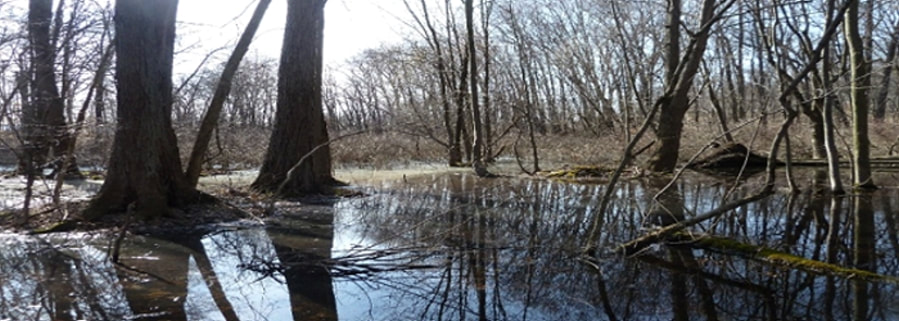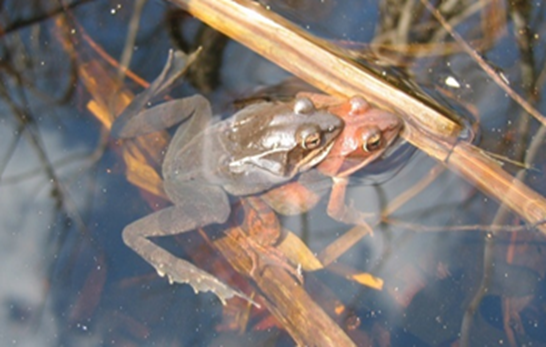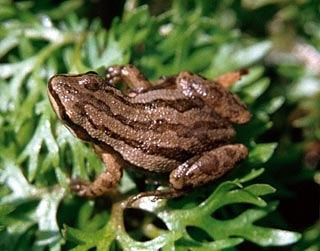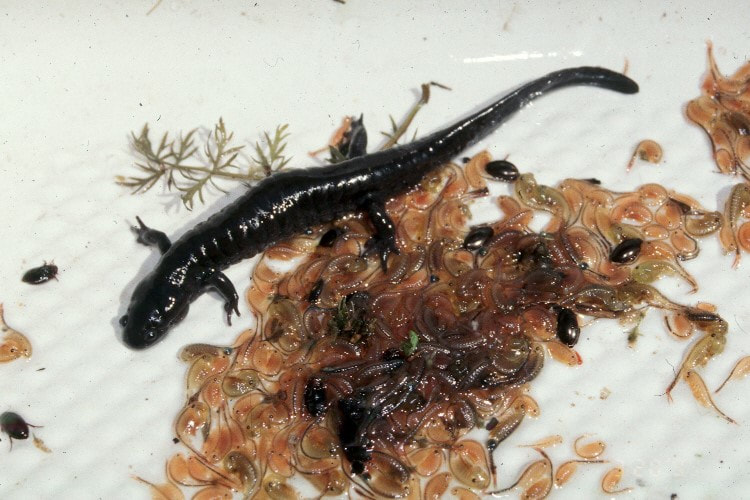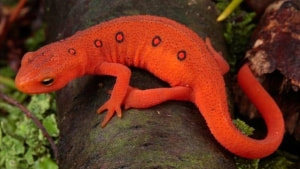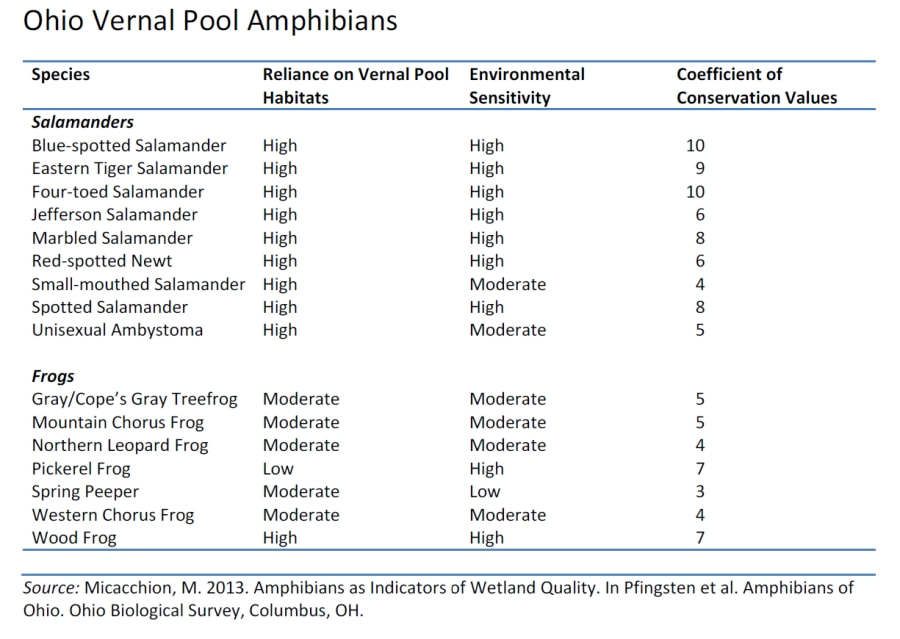AMPHIBIANS OF VERNAL POOLS
Vernal pools provide important breeding habitat for amphibians.
Hydrology—For most vernal pool amphibian species pools should be inundated from March through June, at a minimum, but must also dry down regularly to exclude fish and other amphibian predators.
Microhabitat—Pools with plenty of leaf litter, woody debris, plants, and microtopography support the food web and provide cover.
Forested Landscape—Forested or shrub landscapes surrounding a vernal pool are vital and should also contain other vernal pools to allow for genetic exchange and refuge in times of drought. For instance, spotted salamanders require a large percentage of the habitat within a 200 meter, and wood frogs a 1000 meter (776 acres), radius of the pool be forested.
Conservation—These habitats are disappearing and the species that depend on them are becoming rare. Existing habitats should be protected, and additional vernal pools should be restored to reverse the trend. Unfortunately, these are complex ecosystems that are difficult to replicate.
Hydrology—For most vernal pool amphibian species pools should be inundated from March through June, at a minimum, but must also dry down regularly to exclude fish and other amphibian predators.
Microhabitat—Pools with plenty of leaf litter, woody debris, plants, and microtopography support the food web and provide cover.
Forested Landscape—Forested or shrub landscapes surrounding a vernal pool are vital and should also contain other vernal pools to allow for genetic exchange and refuge in times of drought. For instance, spotted salamanders require a large percentage of the habitat within a 200 meter, and wood frogs a 1000 meter (776 acres), radius of the pool be forested.
Conservation—These habitats are disappearing and the species that depend on them are becoming rare. Existing habitats should be protected, and additional vernal pools should be restored to reverse the trend. Unfortunately, these are complex ecosystems that are difficult to replicate.
Frogs and Toads - Order: Anura (without tail)
|
Life History
Males call to attract a female; once successful they grasp her in amplexus during mating to provide an appropriate position for releasing sperm cells. Fertilization is external; the male releases sperm as the female releases eggs in the water. Tadpoles of vernal pool species are primarily herbivores and metamorphose in the late spring and summer. Most frogs are terrestrial throughout the year and opportunistically eat insects and other invertebrates. Wood frogs and the tree frog species are tolerant of freezing and overwinter under leaf litter. The other frogs overwinter in sediments of ponds and other waters where they do not freeze. |
Treefrogs -Family: Hylidae
|
These small frogs have big voices and can adjust their skin colors to provide camouflage.
|
True Frogs - Family: Ranidae
- Northern Leopard Frog, Lithobates pipiens--Call sounds like a low-pitched snore. Deposits its eggs in large clusters attached to the pool vegetation and substrates.
- Wood Frog, Lithobates sylvaticus--Sensitive species breeds in March. Deposits numerous egg masses together in large collections called “rafts”. Call like the quack of a Mallard Duck
- Pickerel Frog, Lithobates palustris--Breeds in clear coldwater streams or occasionally spring-fed vernal pools. Call is a fast snore.
Salamanders - Order: Caudata (having a tail)
Life History
Most adult vernal pool salamanders migrate to pools in the late winter or early spring where they mate in groups. Males deposit spermatophores on the bottom of the pool and entice females, using aquatic courtship movements and releasing stimulatory chemicals, to pick up the sperm packet. Females then lay a mass of eggs, which swell as they absorb water. Adults leave the pools and return to their subterranean woodland retreats usually within a few days after mating and egg deposition. Eggs develop in 30-60 days, depending on species and water temperatures. Salamander larvae grow quickly and become top vernal pool predators They metamorphose, from gilled larvae to gill-less terrestrial juveniles, and leave the pool after about 2-3 months.
Most adult vernal pool salamanders migrate to pools in the late winter or early spring where they mate in groups. Males deposit spermatophores on the bottom of the pool and entice females, using aquatic courtship movements and releasing stimulatory chemicals, to pick up the sperm packet. Females then lay a mass of eggs, which swell as they absorb water. Adults leave the pools and return to their subterranean woodland retreats usually within a few days after mating and egg deposition. Eggs develop in 30-60 days, depending on species and water temperatures. Salamander larvae grow quickly and become top vernal pool predators They metamorphose, from gilled larvae to gill-less terrestrial juveniles, and leave the pool after about 2-3 months.
Male Salamanders - Family: Ambystomatidae
Mole salamanders spend most of their life below the soil surface and have lungs used for respiration.
- Spotted Ambystoma maculatum--The state amphibian occurs in all 88 counties.
- Small-mouthed Ambystoma texanum--Tolerant of urban areas and small woodlots.
- Eastern Tiger Ambystoma tigrinum--Largest terrestrial salamander uses pools that are deeper and remain inundated longer.
- Jefferson Ambystoma jeffersonianum--Occupies forests with well drained soils when not breeding.
|
Lungless Salamanders - Family: Plethodontidae
Large family of stream and terrestrial salamanders that breathe through their skin. Only one vernal pool breeding species.
- Four-toed Salamander, Hemidactylium scutatum--Called four-toed because there are only four toes on its hind feet. Eggs are laid out of water in a nest of mosses overhanging the pool and guarded by females.
Newts - Family: SalamandridaeAdults are largely aquatic and can inhabit semi-permanent pools thanks to neurotoxins in their skin glands that deter predators.
|
All photos by Mick Micacchion

